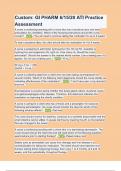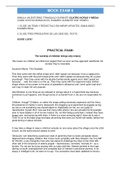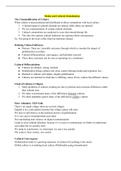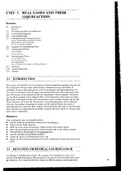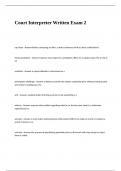GENERAL INFORMATION
The exam is a written examination WITHOUT oral presentation:
• Open questions
• Closed book
Study material needed to learn this course are the slides (and background literature if provided). After each lecture, the lecturers
will give 1 possible exam question to prof. Sleegers. The lessons are NOT recorded.
Lecture 1 was just an introduction. No questions of this lecture will be asked on the exam!
EXAM
• Translational neuroscience: Different stages and different roles for different people
• Open questions
o Reasoning!
o 9 questions: 1 question of 1 person
▪ Questions will be pointed equally
o Key message of each lecture!
o Examples:
▪ What’s the clinical presentation of a disease, do we need biomarkers and which can be good ones?
▪ What are the stages of drug development and explain each stage.
▪ Can model system X be a good system for this disease?
▪ Also be able to give examples about a certain situation!
▪ Explain the pathology in a disease and the clinical presentation
▪ Also out of the box thinking! You get a problem and what would be a therapeutic strategy
▪ Question about diagnostics if this was handled in the lecture
- No interpretation of an MRI scan for example
- Know the different techniques and for what they can be used
, LECTURE 2: TRANSLATIONAL ASPECTS OF HINT 1 NEUROPATHY (AMOR BARRIS)
CHARCOT-MARIE TOOTH DISEASE (CMT)
CMT is a disease with a prevalence of 1 in 2500 that affects the peripheral nervous system (PNS)
• The most common genetic disorder of the PNS
o Peripheral nerves: all the neurons that go from the spinal cord to any extremity
▪ Longest cells in our body
• The most common neuromuscular disorder
THE PERIPHERAL NERVOUS SYSTEM A ND CMT
The PNS is one of the two components of our nervous system and
consists of nerve cells (neurons) and ganglia. These neurons
consist out of a cell body, located in the spine, containing the cell
nucleus, from which the information is transmitted over the axon,
isolated by Schwann cells. The axon terminal is connected with the
muscles and this makes contraction possible.
CMT patients have an axonal dying-back mechanism. This starts
at the tip of the axon and the neuron is dying little by little back
towards the spine as result of axon damage.
CLINICAL PRESENTATION
CMT is not lethal, but it affects the daily life of the patients. In general, motor and sensory
loss occur. Some specific symptoms are:
• Progressive weakness and atrophy of distal limb muscles
• Sensory abnormalities
• Loss of tendon reflexes
• Foot and hand deformities
• Walking impairment
The patients are severely disabling and incurable.
CLASSIFICATION
CMT1 or Demyelinating CMT: Schwann cells are lost
• Signaling goes not that fast as in a normal patient
• Can be measured, by looking at the nerve conduction velocities
o NCV < 38 (Normal situation: > 38)
• Biopsy: Schwann cells = black
o Typical: onion bulb formation → Schwann cells try to isolate the axon, but they fail
CMT2 or Axonal CMT: Schwann cells are fine, but the axon is dying (fragmented)
• Velocity will be normal: NCV > 38
• Axon is slowly dying from the tip back
Intermediate CMT: mix of CMT1 and CMT2
• Can only be studied in a family
• Some will have more CMT1 and some more of the CMT2 type, BUT they all have the same genetic cause!
GENETICS
CMT is very heterogenous:
• Nearly 100 associated genes → 1 gene can cause different (sub)types of CMT
• All modes of inheritance are possible
o Autosomal dominant, X-linked, mitochondrial genes, autosomal recessive,..
• Diverse clinical presentation (symptoms)
,WHAT CAN WE LEARN FROM IT?
The genetics give an insight in the biological function of the genes
in the healthy condition. From this, it will give an idea about the
molecular architecture of the peripheral nerves
• CMT genes are involved in many different biological processes
• Left: tRNA synthesis genes
o KARS, MARS, HARS,…
o Normally: involved in protein translation
o CMT patients: genes have other functions they didn’t
know about
▪ Helping in the formation of the acting mechanisms
▪ Regulating transcription in the nucleus
Conclusion: many genes are necessary to understand the biology!
AXONAL RECESSIVE CMT (AR-CMT)
• Rare subtype of CMT → < 10% of the European CMT
• Higher frequency (30 – 50%) is correlated with higher degree of consanguinity
• Early onset and more sever phenotype
o Early onset: sometimes already at 2 years
• Poorly investigated at molecular basis
o Only around 30 genes are known, 62% is still unsolved
IDENTIFICATION OF A NOVEL AR -CMT
For this study, 2 families were used
• Left: Bulgarian family → consanguinity!
o 3 affected patients
o How: homozygosity mapping
• Right: Belgian family
o Recessive pedigree
o 2 affected patients
o How: whole genome sequencing
▪ Linkage analysis: looking for things that are common in
patients, but absent in controls
• They had 2 different families, but the same variant was shared: HINT1
Next thing to do, was using prediction tools to see what the variant is doing
• C84R → probably damaging
• R37P → most likely to be benign
o Confusing! Were they looking at a SNP that don’t has the gene or
what was happening?
In a following step, they looked at the conservation itself
• C48R → not as conserved at they thought
• R37P → doesn’t seem to affect the protein at all ➔ What’s happening?
Because it’s a rare disease, you don’t expect that the variant has a high population frequency. To confirm this, they look at the
NOMAD database, which contains a lot of genomic data. As a result, they saw that the variant occurs quite commonly. That’s why
they look if there are other HINT1 variants in their cohort of patients
• They identified 8 more mutations
• 33 families → 50 patients
, But still, they were wondering if they had the right gene, the right
mutation. Everything said so, but there was no real evidence.
When looking at the results, the patients had more or less an early
date of onset and also the neuropathy seemed to fit.
That’s why they expanded → genetic and phenotypic screening:
• The most frequent cause: GDAP1 → 12% (and HINT1 →
11%)
• A lot of patients had neuromyotonia
o = hyperexcitability of the peripheral nerves
▪ Can’t make a fist and rapidly open it
o Identified in 60% of the HINT1 patients
o They were asking themselves if it could be used to diagnose the patients
• HINT1 is a biological hallmark
CURRENT GENETIC AND GEOGRAPHICAL LANDSCAPE
• Currently more than 25 causal variants, affecting around 200 patients world-wide
• Several of these variants are founder variants
o = mutation that is the most common variant
o In Europe: R37P, C48R, R95Q, E100G, H112N
o In China: C38R, G93D
• R37P is the most common variant
o Occurs in 80% of the patients
o Ancient Slavic founder allele
o Decreasing gradient from East to West Europe
o Underdiagnosed!
HINT1
= human histidine triad nucleotide binding protein 1
• Small protein which is part of the HIT superfamily
o Characterized by a catalytic motif: HxHxHxx (x = hydrophobic AA)
o Homodimer → 2 binding sites
• Ubiquitously expressed
• In vitro enzymatic assays
o Phosphoramidase → AMP-linked substrates
o SUMO1 Cys protease
• Endogenous substrate is still unknown, BUT they know that HINT1 is involved in transcription
regulation
o Apoptosis & tumorogenesis
ASSOCIATED PATHOLOGIES AND FUNCTIONS
HINT1 is involved in different mechanisms and pathologies:
• Neuropsychiatric disorder
o HINT1 seems to have a bivalent functions → works like a switch
o Causing mechanisms: downregulation of NMDAR
o Schizophrenia, depression & bipolar disorders
• Cardiac hypertrophy
o HINT1 is involved in the transcriptional regulation
• Cancer (Gastric, colorectal, hepatic)
o HINT1 is part of a very complex regulatory network
▪ Can interfere with different points
• CMT disease → mechanism is still unknown
o Axonal recessive neuropathy associated to Neuromyotonia (NMAN)


